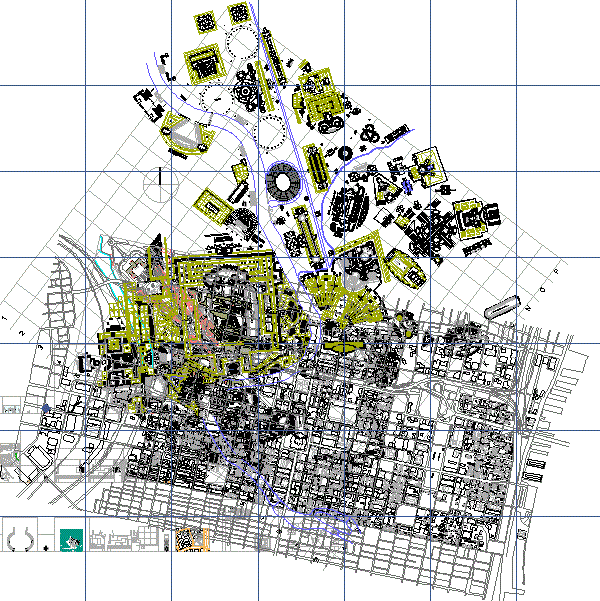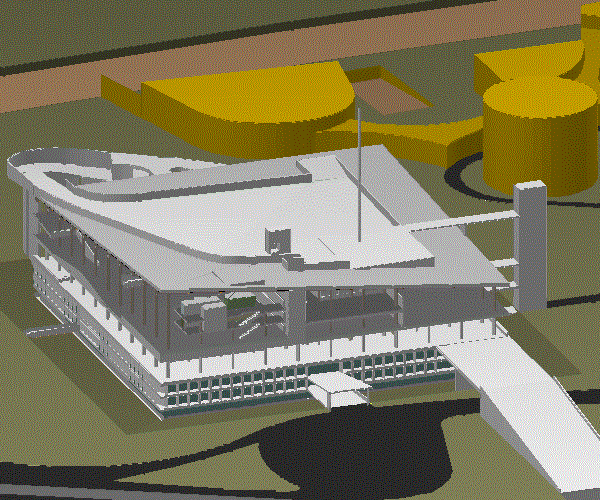2001.01.30
Hyper Architecturism
...working title... It developed from regarding Hyper Quondam and Hyper Modernism. Virilio has already written about hypermodernism. Then “hyperism”, and then ultimately “architecturism”.
Hyper Architecturism... ...document... ...display of all the ideas and manifestations of CAD play, especially the mesh surfaces and extruded rotations. ...including model manipulation and collage/collision.
...document all the steps and procedures, as well as the points of inspiration along the way. ...demonstrate the virtual infinity of digital data (and hence the hyper infinity (diversity) of architecturism).
...solarized architecture... ...they too exhibit a “hyper architecturism”.
images from my 1980s collage art. ...a sense of beyond-ness that they exhibit, plus they are oddly architectural, or at least spatial (maybe even hyper spatial).
Texts for Hyper Architecturism will come primarily from letters to design-l and architecthetics. Hopefully, a new (hyper) textual sense will emerge from utilizing the text freely, such as collaging texts and auto-translating the texts--again, being hyper architectural with the texts.
The concept of “hyper architecturism” also well applies to Piranesi’s Campo Marzio as well as to Piranesi’s other architectural/archaeological publications. ...play with all the imagery. ...also generate a Ichnographia Quondam.
...begin with the (skin) questions: “so what then is architecture...?”
2001.02.05
Hypersize
...what it is really like in the Campo Marzio’s virtual realm. ..slip in and out of being rational and scholarly or experimental and slapdash. ...a hypermodern” effect.
...there came the realization that Le Antichitŕ Romane begins with fragments of the Forma Urbis followed by displays of Rome’s city walls. This brings to mind the notion that Piranesi first presents the pieces of the puzzle followed by the edges of the puzzle. This is interesting in terms of the Il Campo Marzio then being the completion of the puzzle (and beyond), thus providing Hypersize Sagacity with its opening premise.

010206a
| |
2001.02.07
[No Doubt the Artist Suffered] from Architecturism
2001.02.10
reenactionary architecturism
reenactionary 1 : being or exhibiting the qualities of a reenactment 2 : the philosophical or theoretical notion that reenactment underlies much of humanity's cultural and ritualistic traditions as well as humanity's artistic expressions 3 : one of the foremost characterists of late 20th century tourism
architecturism 1 : act, practice, or process of architecture b : manner of action or behavior specific to architecture 2 : abnormal state or condition resulting from an excess of architecture 3 a : doctrine, theory, or cult of architecture b : adherence to a system or a class of architectural principles 4 : characteristic or peculiar feature or trait of architecture

010228a
| |
2001.03.10 10:48
Re: George Washington's Presidential...
I recently read four chapters on the 'preservation' of 'historic' Philadelphia (temporary capital of the United States 1790-1800) in L. Mumford's Highway and the City. I actually found out about these texts from John Young vis-ŕ-vis 'talk' about reenactment and "re" words. It seems that Mumford was lecturing at the University of Pennsylvania in the late 1940s and that was when the historic districts around Independence Hall (actually the Pennsylvania State House) were being newly planned and 'preserved'. I was surprised at how unprecedented American historic preservation was at that time, and then how the preservation actions taken in Philadelphia in turn set America's historic preservation precedents and standards. Growing up in Philadelphia in the 1960s and going to architecture school here in the 1970s (the Bicentennial and all that, like Legionnaire's Disease) made one hyper aware of historic preservation; I didn't think then at how 'new' it all was.
Another interesting factor I found out is that half of Philadelphia's historic district is run by the Federal government and half is run by the State of Pennsylvania--I'm pretty sure Independence Hall is still owned by Pennsylvania, and the ruins of the Morris House are within the part run by Pennsylvania as well.
Like Franklin Court (a few blocks away) designed by Venturi and Rauch in the early 1970s, the Robert Morris House is just another example of Philadelphia's great collection of premiere virtual houses.
You'd think I'd seen it all here too many times already, but the truth is that with each recent visit to Philadelphia's Historic National Park (the area run by the Federal government) I become more impressed by it each time I'm there. Maybe it's because I'm getting older myself and like to see things that endure time, but I also think it's because a nice job was done in the first place. Independence Mall (the area run by Pennsylvania) was oddly dear to me as well, even though most didn't like it because it really was lifeless, thus it is now being redone. Maybe the best plan for the Mall now is for it to be redone every twenty years or so--American [metabolic] Dreaming at its best?
|